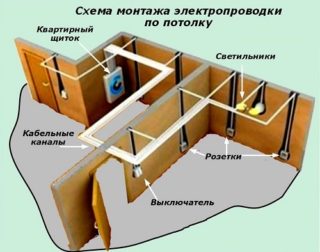Fastening the wiring to the ceiling is not uncommon; recently, more and more people, making repairs in their apartment or house, prefer this method. This is due to a large number of advantages, the main of which is convenience. However, before deciding to wire the ceiling, you need to familiarize yourself with the disadvantages of the method.
- Cost comparison
- Methods for laying wiring on the ceiling for different types of surfaces
- Wooden ceiling base
- Metal surface
- Reinforced concrete floor
- False ceilings
- Preparatory work
- Rules for the selection of material and wire cross-section
- Making a circuit
- Slitting and wiring
- Disconnection - the final stage
- Common mistakes when installing electrical wiring on the ceiling
Cost comparison
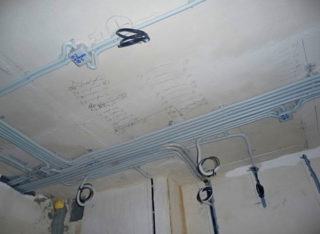
For a more visual comparison of costs, it is recommended to consider everything with a specific example.
During the replacement of electrical communications in a four-room apartment with the installation of a traditional switchboard that was not equipped with several automatic devices, and when laying conductive conductors in the walls and on the floor, it took 2045 meters of wires. This number includes the connection of lighting devices, outlet groups, weak current. Standard minimum set required for new wiring.
If an electrician is run along the ceiling, with a similar number of outlets, lighting fixtures will require almost 500 meters of wire more.
Consumables Required Comparison Chart:
| Consumables | Floor wiring, meters | Ceiling wiring, meters |
| NYM 3 * 6 | 15 | 18 |
| NYM 3 * 4 | 70 | 70 |
| NYM 3 * 2.5 | 610 | 810 |
| NYM 3 * 1.5 | 600 | 780 |
| NYM 5 * 1.5 | 100 | 140 |
| PV3 1 * 4 | 55 | 55 |
| PV3 1 * 6 | 45 | 45 |
| TV cable | 100 | 100 |
| UTP cable | 450 | 470 |
At the same time, the difference is limited not only by the amount of material, but also by the need to groove the walls for a larger footage. And this entails additional time, effort and financial costs.
As practice shows, the cost of the wiring carried out on the ceiling is several tens of thousands of rubles more expensive.
Methods for laying wiring on the ceiling for different types of surfaces
Wooden ceiling base
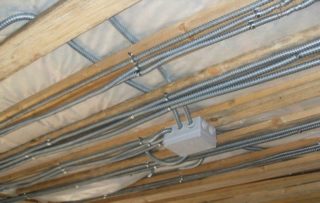
Wiring under a stretch ceiling on a wooden surface is carried out using steel pipes. The inner diameter directly depends on the size of the wires. If the cross-section allows, it is allowed to lay several cables in it.
Installation process:
- Make a markup where cables will soon be laid.
- Mark and install feed-through and junction boxes.
- Cut the pipes to the required length, fix them securely on the ceiling surface and weld all the elements.
- It is important to make all ascents, descents and turns strictly at right angles or a branch from the mounting box.
- Using a broach, fix the cable securely in the interval from one box to another.
- Organize a grounding system.
The final stage - it is imperative to check the integrity and operability of electrical communications.
Metal surface
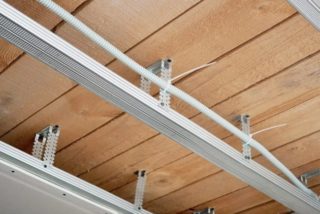
Metal is a good conductor of electricity, so it is very important to comply with all the requirements of regulatory documents and rules during installation work. If the category of the apartment and conditions allow, the wiring should be placed in pipes made of electrical plastic.
The installation algorithm is completely identical to the technology of wiring on a wooden ceiling.
Reinforced concrete floor
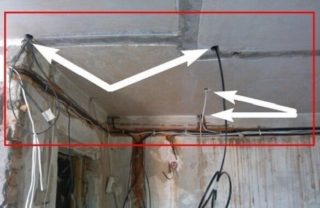
If we are talking about a reinforced concrete ceiling, the wiring must be carried out through special channels. The only inconvenience of implementation is that there are remnants of concrete piles inside and at the edges of the slabs, which greatly complicates the cable pulling.
There are the following methods designed for open cable laying on reinforced concrete slabs:
- special mounting brackets;
- in electrical pipes made of plastic, which are attached to clips;
- in plastic corrugated pipes, which are securely fastened with special clips;
- in steel protective bellows, which are secured with clamps or brackets.
Before proceeding with the installation work, it is important to make sure that this method is realizable.
False ceilings
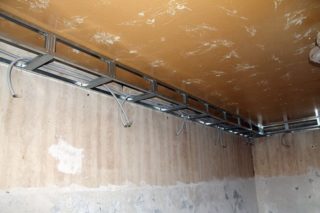
False ceilings are suspended. Such designs are extremely popular, as they create an attractive interior and allow various communications to be hidden inside. However, there is one significant drawback - limited access to wires and cables mounted to junction boxes.
Plasterboard panel, rack, cassette and stretch ceilings, as well as an electrically conductive panel can be installed in any room. Taking into account the environment, the wiring under the ceiling is carried out as follows:
- Attached cables to the base ceiling.
- If the base ceiling is made of wood, the wires are placed in steel pipes.
- For reinforced concrete and metal surfaces, corrugated products or electrical pipes made of plastic are used.
If there is no experience in carrying out such work, it is better to hire a team of professional builders and handymen who will quickly, efficiently and, most importantly, safely perform the installation.
Preparatory work
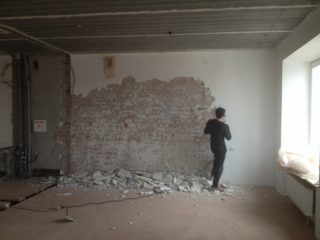
It is necessary to carry out all the preparatory measures that will further simplify the implementation of the main work and reduce the time spent. This will require:
- Remove finishing materials such as wallpaper, decorative plaster, etc. from the wall surface.
- Disconnect old wiring. To do this, you need to fold the current-carrying conductors from the power switch in the entrance and connect a temporary carrier designed for power tools to it.
- If an electric meter is installed in an apartment and for work it is required to remove the protective seal, you will additionally need to visit the power supply company and write a corresponding statement.
- Dismantle all old outlets, switches, electrical panels and junction boxes.
When carrying out work on dismantling old wiring, it is important to take care of personal safety.
Rules for the selection of material and wire cross-section

Before installation work, it is important to familiarize yourself with the type of wires and their cross-section. The assortment in hardware stores is incredibly large.
There are two main types - PVS and VVN. The abbreviation of the latter means vinyl-vinyl naked: each conductor is in vinyl insulation, and everything is united by another insulating layer. As a rule, in hardware stores you can find only single-core cables of this type, which means that the core is cast.
PVA: connecting wire with vinyl insulation. The most common copper wire. It is used not only for wiring, but also for the manufacture of electrical appliances. The vein consists of a large number of small wires. This design feature has a beneficial effect on electrical conductivity and service life.
To choose a wire with the correct cross-section, you need to familiarize yourself with the tables from the PUE manual (Rules for Installing Electrical Appliances).
Making a circuit
This is done as follows: schematically, on a sheet of blank paper, mounting boxes are depicted in which the twists will be concentrated. The assembly board of the machines, switches and light bulbs are also indicated. The twists in such boxes are represented by rectangles, and the dots are the wires that are twisted in it.
Slitting and wiring
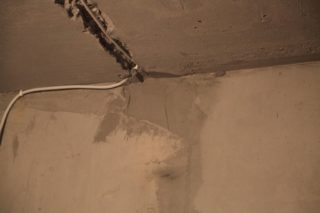
After completing all the preparatory activities, you can start work. With the help of a pencil or felt-tip pen, lines are drawn along which the strobe will be cut.
Holes for switches and sockets are drilled with the help of a perforator crown. It is important to use a Euro-crown during operation, since the dimensions of the mounting boxes have European standards. By modern standards, sockets are mounted at intervals of 0.4 meters from the floor, and switches are mounted at intervals of 0.9 meters.
Next, they start cutting the grooves. Work is carried out using a groove cutter. The tool is expensive, so an ordinary grinder of the smallest number can be used as an analogue. You need to use a disc for a stone. Parallel to the outlined lines, two cuts are made, the distance between them (15-20 mm) is hollowed out with a perforator.
Now you can start laying the wires. They are securely fixed in the wall with plaster and alabaster. When preparing building material, the proportions of 1: 1 are observed.
If in the future it is planned to install a false ceiling, the wires are threaded into a special protective armored hose and attached to the ceiling using impact dowels.
Disconnection - the final stage
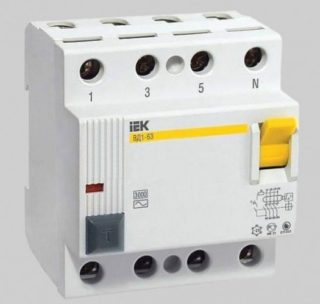
It is important not to forget about the disconnection. Using the previously prepared diagram, the wires are insulated and twisted in junction boxes. Further, machines, RCDs, switches and sockets are connected to the network. If a suspended ceiling is installed, you must first insert soffits and lamps into the prepared holes.
When all the activities are performed, the network operability is checked, there should be no short circuit.
Common mistakes when installing electrical wiring on the ceiling
The most serious, but at the same time, common mistake that homeowners make is trusting non-professionals who are unable to do the job well, or the desire to do everything on their own without experience.
Often, ceiling wiring is installed without protective bellows and junction boxes, which can cause a fire. According to the requirements, all wires running along the ceiling must be enclosed in a corrugation made of special non-flammable plastic or a metal hose.
Another mistake is connecting all electrical and lighting fixtures to one residual current device. If the load exceeds the permissible parameters or an abnormal situation occurs, all devices will be de-energized at the same time.
It is quite easy to avoid mistakes and violations. The main thing is to realize that all electrical components on the ceiling must meet the requirements for laying external wiring. All conductive conductors are enclosed in special protective flasks. Fastening directly to the ceiling surface must be carried out using special mounting clips.

